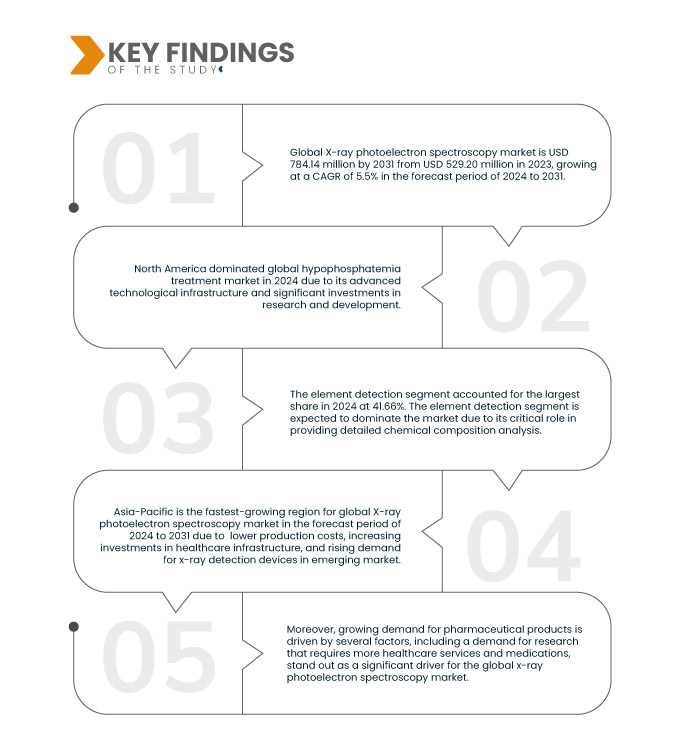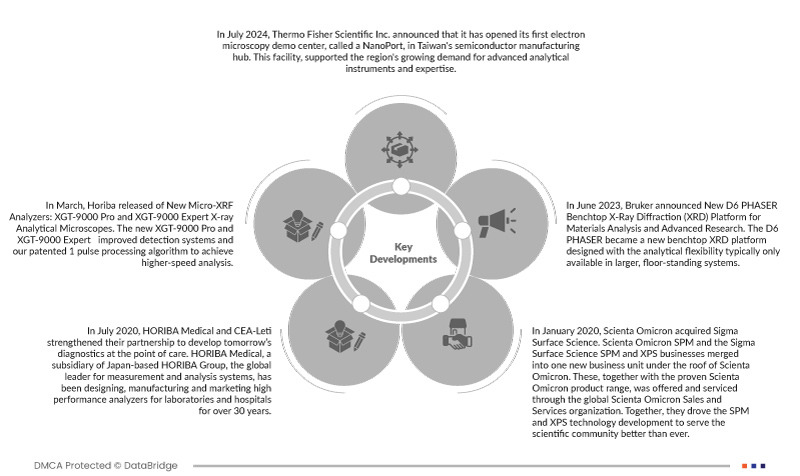Increasing global demand for medical research, pure and safe drugs, minimal medication error, and technological advancements are some of the critical drivers of the X-ray Photoelectron Spectroscopy (XPS) market. As medical research becomes increasingly advanced, there is a growing need for precise analytical techniques to investigate and develop new biomedical materials, drug delivery systems, and diagnostic devices. XPS plays a crucial role in this field by providing detailed information about the surface composition and chemical states of materials used in medical applications. This capability is essential for understanding interactions between drugs and biological systems, optimizing biomaterials for implants and prosthetics, and ensuring the quality and safety of medical devices.
Access Full Report @ https://www.databridgemarketresearch.com/reports/global-x-ray-photoelectron-spectroscopy-market
Data Bridge Market Research analyzes that the Global X-Ray Photoelectron Spectroscopy (XPS) Market is expected to grow at a CAGR of 5.5% in the forecast period of 2024 to 2031 and is expected to reach USD 784,136.56 million by 2031. The element detection segment is projected to propel the market growth due to its critical role in providing precise and detailed elemental analysis for various applications.
Key Findings of the Study
- Rise in Demand for Medical Research
Increasing global demand for medical research, pure and safe drugs, minimal medication error, and technological advancements are some of the critical drivers of the X-ray Photoelectron Spectroscopy (XPS) market. As medical research becomes increasingly advanced, there is a growing need for precise analytical techniques to investigate and develop new biomedical materials, drug delivery systems, and diagnostic devices. XPS plays a crucial role in this field by providing detailed information about the surface composition and chemical states of materials used in medical applications. This capability is essential for understanding interactions between drugs and biological systems, optimizing biomaterials for implants and prosthetics, and ensuring the quality and safety of medical devices.
Report Scope and Market Segmentation
|
Report Metric |
Details |
|
Forecast Period |
2024 to 2031 |
|
Base Year |
2023 |
|
Historic Year |
2022 (Customizable to 2016–2021) |
|
Quantitative Units |
Revenue in USD Million |
|
Segments Covered |
Usage (Element Detection, Contamination Detection, Density Estimation, and Empirical Formula Determination), Application (Material Science, Surface Chemistry, Medical Devices, Thin Films and Coatings, Microelectronic Devices, Medical and Biological Samples, Geologic Materials, and Others), X-ray Spot Size (Upto 50 μm, 51-200 μm, and Above 200 μm), Method (Qualitative Method, Quantitative Method, and Semi-Quantitative Method), Industry (Semiconductors & Electronics, Metal & Energy, Healthcare, Chemical, Automotive, Aerospace & Defense, Packaging, Printing, and Others) |
|
Market Players Covered |
Thermo Fisher Scientific Inc. (U.S.), HORIBA (Japan), Ltd., SPECS GmbH (U.K.), Staib Instruments (Germany), Scienta Omicron (Germany), Hitachi High-Tech India Private Limited (Japan), Hitachi, Ltd., Kratos Analytical Ltd. (U.K.), Intertek Group plc (England), Nova Ltd.(Israel), JEOL Ltd. (Japan), Spectris (U.K.), ULVAC-PHI (Japan), INCORPORATED., LANScientific. (China), and Bruker (U.S.) among others |
|
Data Points Covered in the Report |
In addition to the insights on market scenarios such as market value, growth rate, segmentation, geographical coverage, and major players, the market reports curated by the Data Bridge Market Research also include depth expert analysis, patient epidemiology, pipeline analysis, pricing analysis, and regulatory framework |
Segment Analysis
The X-Ray photoelectron spectroscopy market is categorized five notable segments based on usage, application, x-ray spot size, method, and industry.
- On the basis of usage, the market is segmented into element detection, contamination detection, density estimation and empirical formula determination
In 2024 the element detection segment is expected to dominate the market
In 2024 the element detection segment is expected to dominate the market with a market share of market share of 41.66% due to its critical role in providing detailed chemical composition analysis.
- On the basis of application, the market is segmented into material science, surface chemistry, medical devices, thin films and coatings, microelectronic devices, medical and biological samples, geologic materials, and others
In 2024, the material science segment is expected to dominate the market
In 2024, the material science segment is expected to dominate the market with a market share of 31.61% due to its essential role in analyzing and characterizing materials at the atomic level.
- On the basis of x-ray spot size, the market is segmented into up to 50 μm, 51-200 μm, above 200 μm. In 2024, the the up to 50 μm segment is expected to dominate the market with a market share of 61.21% due to its optimal balance between resolution and sample analysis efficiency
- On the basis of method, the market is segmented into qualitative method, quantitative method, and semi-quantitative method. In 2024, the qualitative method segment is expected to dominate the market with a market share of 45.99% due to its crucial role in identifying and analyzing the chemical composition and electronic states of materials
- On the basis of industry, the market is segmented into semiconductors & electronics, metal & energy, healthcare, chemical, automotive, aerospace & defense, packaging, printing and others. In 2024, the semiconductors & electronics segment is expected to dominate the market with a market share of 28.08% due to its critical need for precise material characterization and quality control in advanced technological applications
Major Players
Data Bridge Market Research recognizes the following companies as the major players in the market that includes Thermo Fisher Scientific Inc. (U.S.), HORIBA (Japan), Ltd., SPECS GmbH (U.K.), Staib Instruments (Germany), and Scienta Omicron (Germany) among others.
Market Development
- In July 2024, Thermo Fisher Scientific Inc. announced that it has opened its first electron microscopy demo center, called a NanoPort, in Taiwan's semiconductor manufacturing hub. This facility, supported the region's growing demand for advanced analytical instruments and expertise. This strategic move helped Thermo Fisher strengthened their relationship with semiconductor customers and expand its presence in the region
- In March 2023, In March, Horiba released New Micro-XRF Analyzers: XGT-9000 Pro and XGT-9000 Expert X-ray Analytical Microscopes. The new XGT-9000 Pro and XGT-9000 Expert have improved detection systems and our patented 1 pulse processing algorithm to achieve higher-speed analysis. These new capabilities contribute to time reductions and efficiencies of material analysis
- In July 2020, HORIBA Medical and CEA-Leti strengthened their partnership to develop tomorrow’s diagnostics at the point of care. HORIBA Medical, a subsidiary of Japan-based HORIBA Group, the global leader for measurement and analysis systems, has been designing, manufacturing and marketing high performance analyzers for laboratories and hospitals for over 30 years. This expertise has made the company one of the world leaders in Hematology and a key player in the Hemostasis and Clinical Chemistry activity
- In January 2020, Scienta Omicron acquired Sigma Surface Science. Scienta Omicron SPM and the Sigma Surface Science SPM and XPS businesses merged into one new business unit under the roof of Scienta Omicron. These, together with the proven Scienta Omicron product range, was offered and serviced through the global Scienta Omicron Sales and Services organization. Together, they drove the SPM and XPS technology development to serve the scientific community better than ever
- In June 2023, Bruker announces New D6 PHASER Benchtop X-Ray Diffraction (XRD) Platform for Materials Analysis and Advanced Research. The D6 PHASER was a new benchtop XRD platform designed with the analytical flexibility typically only available in larger, floor-standing systems. With its wide range of capabilities, the D6 PHASER enabled more XRD applications for new markets and user communities
For more detailed information about the global X-ray Photoelectron Spectroscopy (XPS) market report, click here – https://www.databridgemarketresearch.com/reports/global-x-ray-photoelectron-spectroscopy-market













